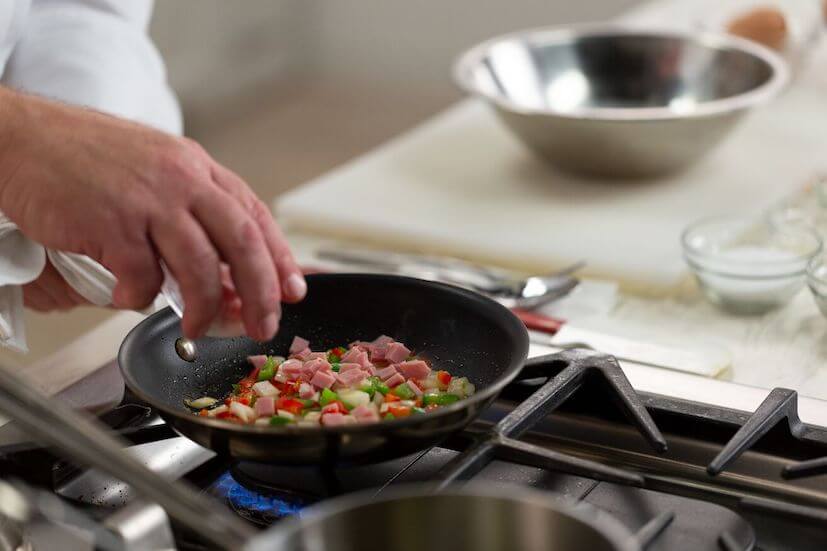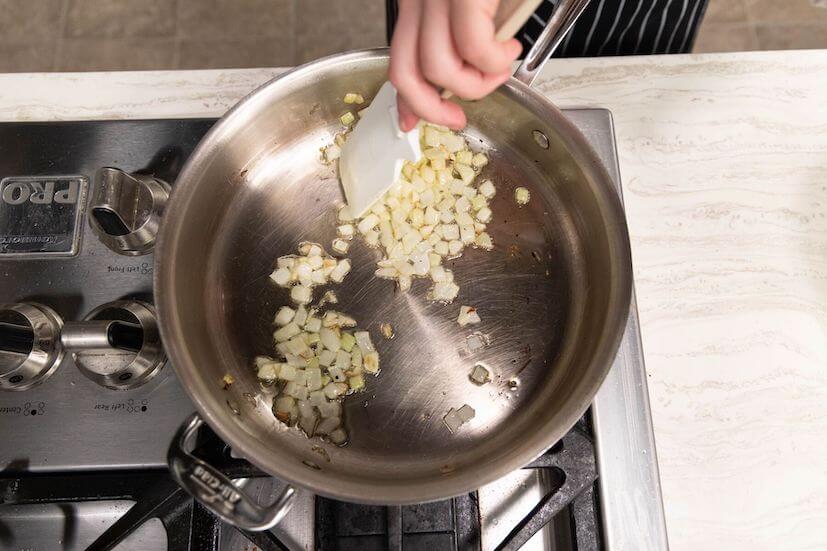How to Sauté: 4 Easy Steps to Perfect this Cooking Technique
No matter if you’re cooking an eggplant, ground beef, or piece or tofu, you have seemingly endless cooking methods to choose from. However, one of the most versatile methods is sautéing.
Sautéing—from the French word sauté, meaning “to jump”—involves heating a small amount of fat in a pan over medium-high heat. Food cooks quickly, leading to ingredients that are cooked all the way through yet still moist and firm.
To learn how to sauté, follow these four steps.
1. Heat Your Pan Over Medium-High Heat
No matter what type of food you’re sautéing, the first step is to heat your pan on the stove. While many types of frying pans can be used to sauté food, stainless steel pans are one of the best options due to their lightweight yet durable nature as well as their ability to evenly conduct heat.
When you sauté, you want all your ingredients to come into direct contact with the bottom of the pan. So choose a pan that is large enough to hold all of your ingredients.
When you’re choosing a pan shape, opt for a “frying pan” rather than a “sauté pan.” The latter has straight sides which can make it more difficult to stir food.
Once your pan is hot, it’s time to add a small amount of fat. Since you’ll be heating this fat over relatively high heat, it’s best to choose an oil with a high smoke point. Some options include safflower oil, corn oil, and vegetable oil. You should avoid using extra virgin olive oil since it will begin smoking when it reaches temperatures above 375ºF.
While you can use butter, it will start smoking once it reaches 350ºF. A better option is to use clarified butter, which has a higher smoke point.
Once you’ve chosen your fat, add it to the pan and allow it to heat up. Next, gently swirl the pan so the entire bottom is covered with a thin layer of fat.
2. Add the Ingredients
Now it’s time to add your ingredients! If you want your food to reach the same level of doneness, cut your ingredients into uniformly-sized pieces.
In order to keep the pan hot and prevent food from sticking, avoid crowding the food in the pan. If you don’t have a pan that is large enough to fit all your food in a single layer, it’s best to sauté your ingredients in multiple batches rather than crowd everything in at once.
3. Stir the Ingredients
You don’t need to constantly mix your ingredients when sautéing, but you should give them a good stir every few minutes. This will prevent the food from sticking as well as allow for even cooking.
There’s no one right way to stir—you can use a spatula, wooden spoon, or another cooking utensil.
However, with a quick flick of the wrist and a bit of practice, you can flip your ingredients with nothing but your hand. While this technique may appear intimidating, it’s actually quite simple!
Grab the handle of the pan with one hand then quickly move the pan an inch or two forward. The ingredients should sail up the curved edge of the pan and jump into the air. Your job is to make sure the pan is in a place to catch the ingredients when they fall!
By spending some time practicing this technique, you’ll be able to quickly toss your ingredients while also saving a few dirty utensils in the process.
4. Remove From Heat
Like with any cooking method, it’s crucial you remove your food from the heat at the proper time in order to achieve the results you’re looking for.
Sautéing is meant to maintain a food’s texture and moisture while quickly heating it up. If you remove your ingredients too soon, you’ll end up with cold or undercooked results. And if you sauté a few minutes too long, the food may be mushy or burnt.
Typically you only need to sauté vegetables for a few minutes. They’re ready when they reach your desired level of doneness, or when you can insert a fork with just a little bit of pressure.
If you’re sautéing meat like chicken breast or skirt steak, you’ll want to ensure the meat reaches a temperature that makes it safe to eat. But don’t overcook or you’ll end up with dry meat! You can use a meat thermometer to check the internal temperature if you’re unsure if the meat is properly cooked.
Explore More Cooking Methods
While sautéing is an important and versatile cooking method, it’s just one technique in a long list. You can also bake, boil, grill, steam, sous vide, and more!
You can gain an understanding of these different cooking methods on your own. However, that’s not the only way!
If you’re serious about expanding your culinary knowledge and skills, culinary school may be for you. Escoffier’s culinary arts programs are taught by experienced chef instructors who can offer you support as well as some helpful tips.
And since Escoffier offers programs both in-person and online, it may be easier than you thought to work culinary school into your life!
This article was originally published on Dec 6, 2013 and has since been updated.







Recent Comments